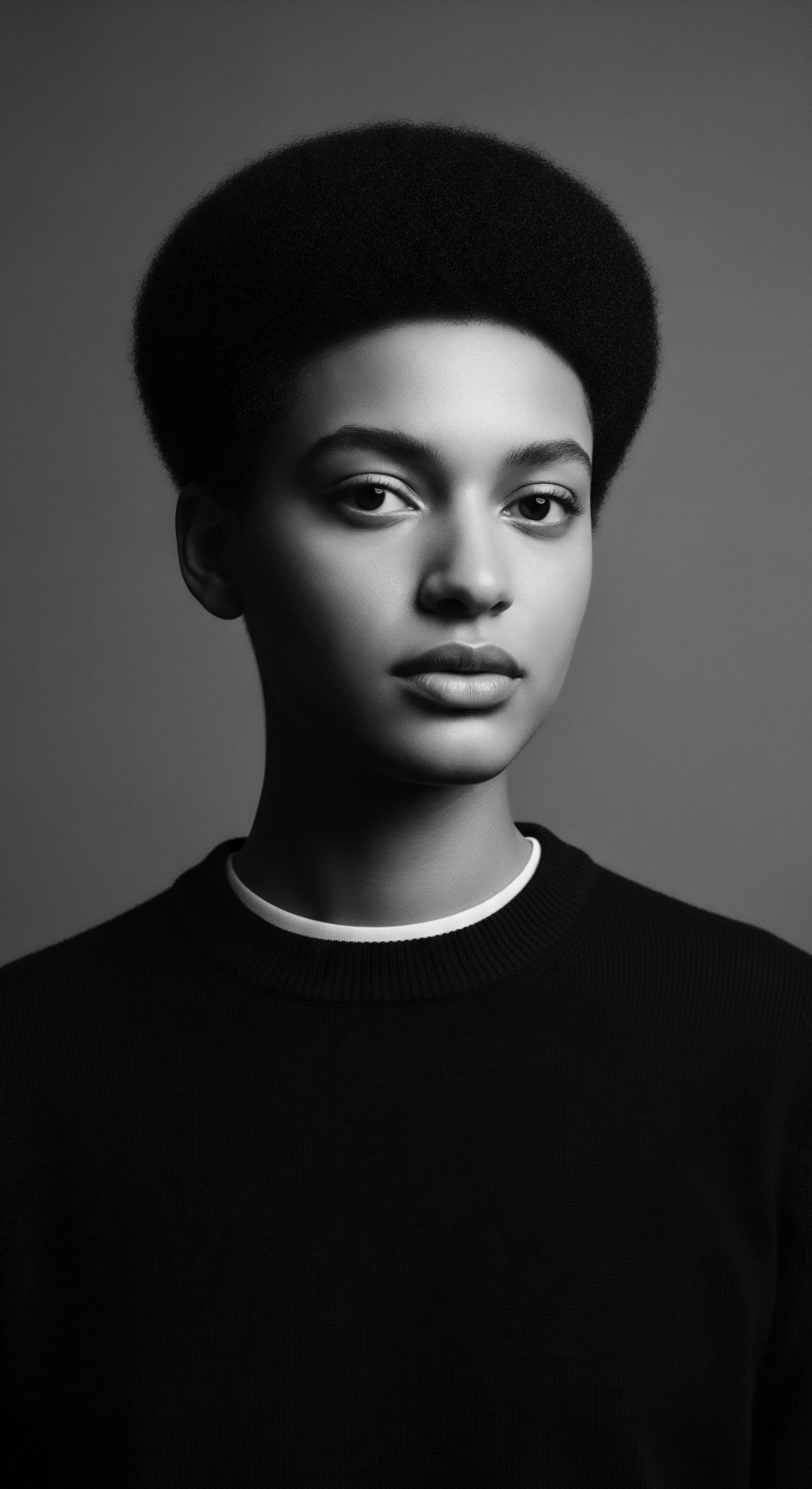
Fundamentals
The concept of Overnight Hair Protection, at its fundamental level, refers to the practice of safeguarding one’s hair from potential damage, tangling, and moisture loss while sleeping. This practice is particularly vital for those with textured hair, including various forms of Black and mixed-race hair, where the delicate nature of curls, coils, and kinks makes them more susceptible to friction-induced breakage and dryness. It is a preventative measure, a thoughtful act of care that seeks to preserve the hair’s integrity and manageability, ensuring it remains healthy and vibrant.
The immediate meaning of this term lies in its direct application ❉ establishing a barrier between delicate hair strands and the potential aggressors of sleep. These aggressors often include rough pillowcases, which can absorb moisture and create friction, leading to frizz, knots, and breakage. The intention behind Overnight Hair Protection is to minimize these negative interactions, allowing the hair to retain its natural oils, maintain its style, and reduce the need for extensive detangling or restyling in the morning.
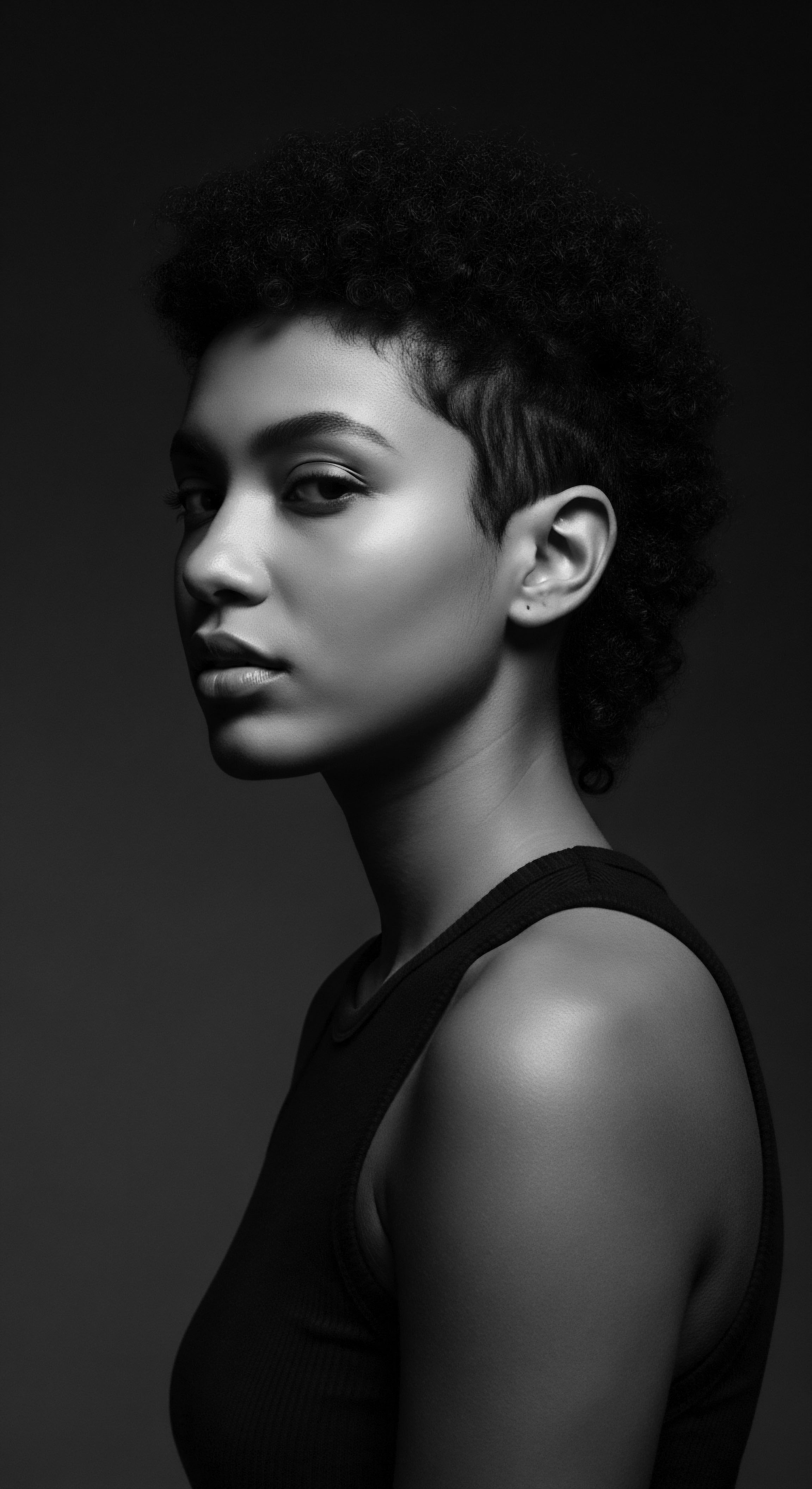
Simple Techniques for Nighttime Hair Care
For individuals new to this practice, understanding simple, accessible methods can be a helpful starting point. These techniques, while straightforward, carry echoes of long-standing traditions of hair preservation.
- Pineapple Method ❉ This involves gathering all hair to the very top of the head, securing it loosely with a soft scrunchie or hair tie, creating a “pineapple” shape. This position lifts the hair off the neck and pillow, reducing compression and preserving curl patterns.
- Loose Braids or Twists ❉ Dividing hair into a few large, loose braids or twists before bed can prevent tangling and stretch out curls gently, preparing them for the next day’s styling. This is especially beneficial for longer textured hair.
- Satin or Silk Pillowcases ❉ Swapping cotton pillowcases for those made of satin or silk is a simple yet effective step. These smoother fabrics reduce friction against the hair cuticle, minimizing frizz and breakage, and allowing hair to glide rather than snag.
Each of these methods, while seemingly modern in their phrasing, carries an ancestral resonance, reflecting a deep, intuitive understanding of hair’s needs that has been passed down through generations.
Overnight Hair Protection is the mindful practice of shielding hair from nocturnal stressors, a simple yet profound act of preservation for textured strands.

Intermediate
Moving beyond the foundational aspects, the concept of Overnight Hair Protection gains a deeper layer of significance, particularly when viewed through the lens of textured hair heritage. It is not merely a practical routine; it embodies a sustained dialogue between elemental hair biology and centuries of inherited wisdom. This practice, at its core, represents a deliberate strategy to counteract environmental and mechanical stressors that could compromise the delicate architecture of textured strands, thereby maintaining their intrinsic health and vitality.
The intermediate meaning of Overnight Hair Protection extends to understanding the subtle interplay of moisture retention, cuticle integrity, and tension management. Textured hair, characterized by its unique helical structure, possesses a naturally raised cuticle layer, which can make it more prone to moisture loss and tangling. When hair rubs against abrasive surfaces during sleep, these cuticles can lift further, leading to increased friction, frizz, and eventual breakage. Thus, the objective of nighttime protection is to create an optimal micro-environment for the hair, one that minimizes external stressors and supports its natural moisture balance.
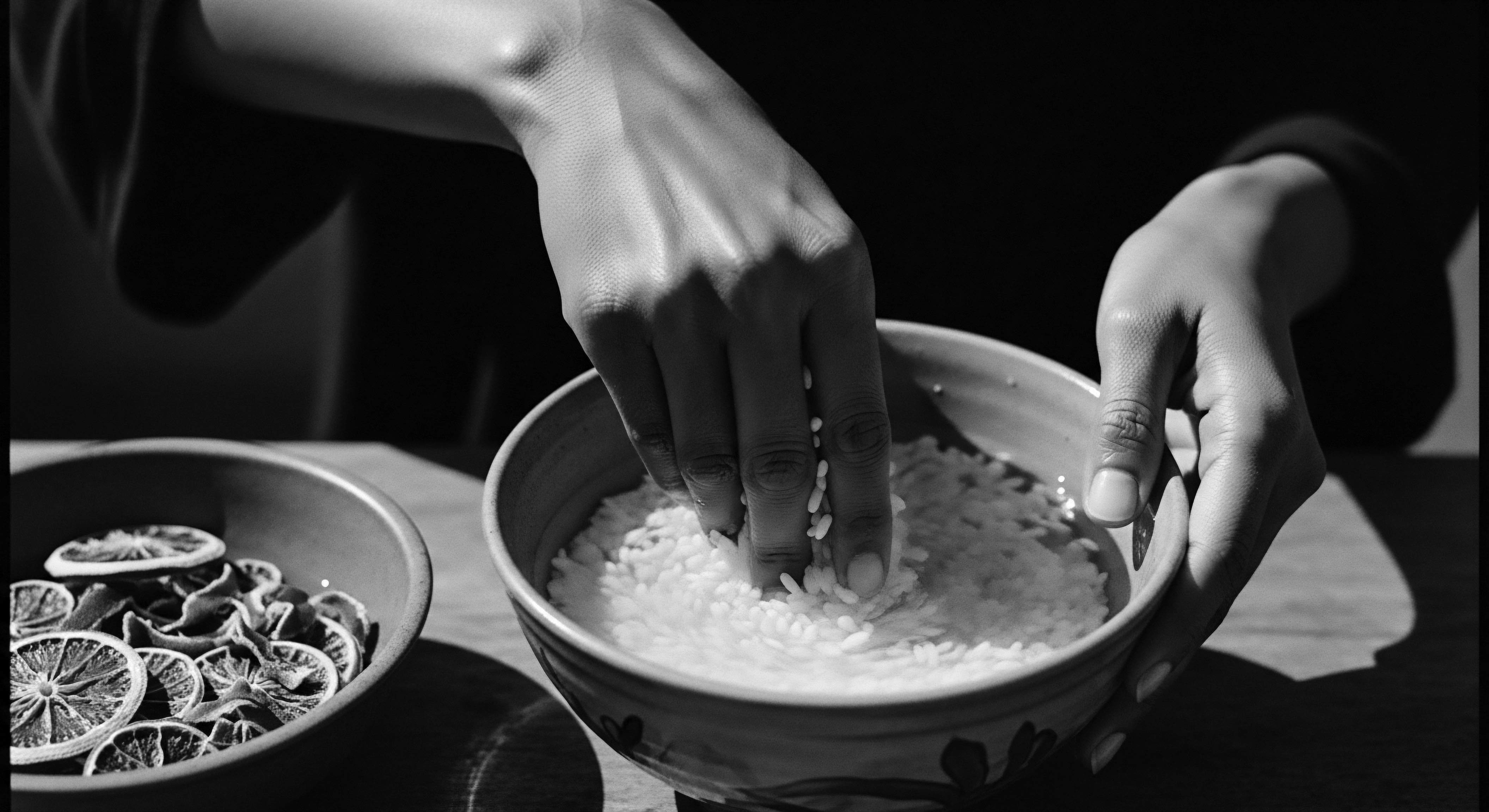
The Science of Nighttime Preservation
Delving into the mechanisms behind effective overnight care reveals a thoughtful application of scientific principles, often unknowingly mirrored in ancestral practices.
- Friction Reduction ❉ The primary purpose of materials like satin or silk is to reduce the coefficient of friction between the hair and the sleeping surface. Unlike cotton, which has microscopic fibers that can catch and pull on hair strands, silk and satin provide a smooth, frictionless glide. This minimizes mechanical damage, preserving the hair’s cuticle layer and preventing the formation of knots and tangles.
- Moisture Retention ❉ Cotton is a highly absorbent material, capable of drawing moisture from hair, which can lead to dryness and brittleness, particularly for already moisture-sensitive textured hair. Silk and satin, being less absorbent, allow hair to retain its natural oils and any applied conditioning treatments, supporting optimal hydration levels.
- Style Preservation ❉ Beyond preventing damage, overnight protection techniques like loose braiding or twisting, or the “pineapple” method, help to maintain existing curl patterns or stretched styles. This reduces the need for daily manipulation, which in itself can be a source of mechanical stress and breakage for textured hair.
The continuous engagement with these protective measures speaks to a deep, communal understanding of hair’s needs. It is a practice born from necessity, refined through experience, and passed down through generations, forming a tangible link to ancestral hair care traditions.
Overnight Hair Protection is a nuanced understanding of hair’s nocturnal vulnerabilities, addressing friction and moisture loss with methods that echo ancestral wisdom and scientific validation.
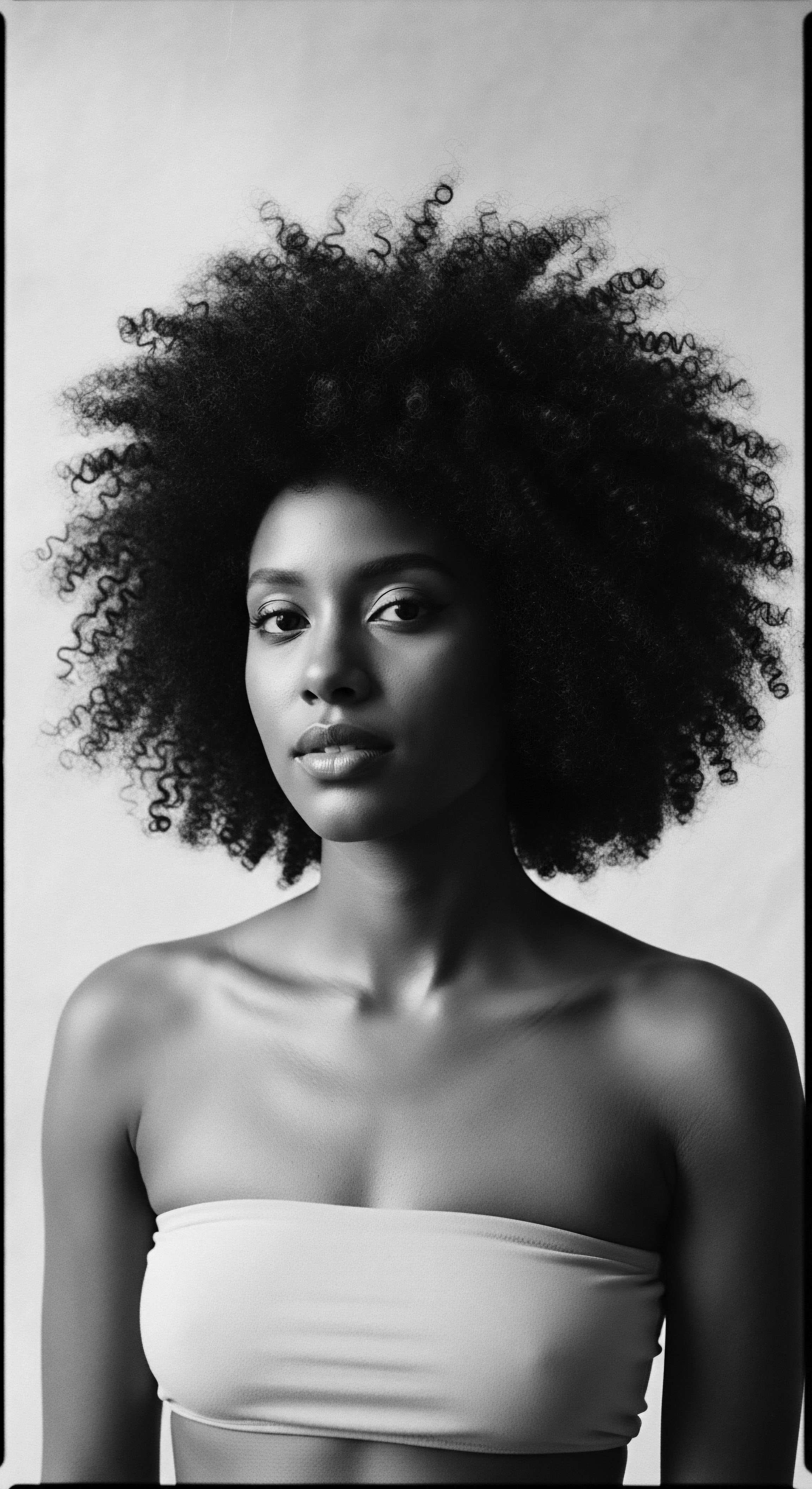
Historical Echoes in Modern Practice
The current widespread use of satin bonnets and silk scarves for overnight hair protection among Black and mixed-race communities is not a recent phenomenon. It is a direct continuation of practices rooted deeply in African and diasporic history. Headwraps, known by various names such as ‘dukku’ in Ghana, ‘gele’ in Nigeria, or ‘doek’ in South Africa, have been traditional attire in African countries for centuries, serving multiple purposes beyond mere adornment. They conveyed social status, marital status, ethnicity, and even emotional states,
During the transatlantic slave trade, the significance of head coverings shifted dramatically. Enslaved Black women were often forced to wear head coverings, not as symbols of status, but as markers of subjugation and to visibly distinguish them as enslaved people, This forced uniformity aimed to strip away identity and cultural expression. However, Black women, with remarkable resilience, transformed these symbols of oppression into acts of resistance and creativity. They adorned their wraps with feathers, jewels, and embroidery, reclaiming them as expressions of cultural pride and individual artistry.
This adaptive spirit of preserving hair under wraps, even in the face of dehumanization, laid a profound foundation for the modern practice of overnight hair protection. The hair bonnet, a seemingly simple garment, carries centuries of Black resilience and Black excellence within its very fabric.
| Historical Period/Context Pre-Colonial Africa (Centuries Ago) |
| Traditional Practice/Tool Headwraps (Dukus, Geles, Doeks) |
| Underlying Principle for Overnight Hair Protection Protection from elements, preservation of intricate styles, indication of status and identity. Used during sleep for preservation. |
| Historical Period/Context Transatlantic Slave Trade (18th-19th Century) |
| Traditional Practice/Tool Forced Head Coverings |
| Underlying Principle for Overnight Hair Protection Despite oppressive intent, enslaved Black women adapted coverings to protect hair, a quiet act of resistance and preservation of identity. |
| Historical Period/Context Post-Slavery & Early 20th Century |
| Traditional Practice/Tool Reclaimed Headwraps, Bonnets |
| Underlying Principle for Overnight Hair Protection Symbol of cultural pride and self-expression. Became established tools for sustaining and protecting hair texture, popularized by figures like Madame C.J. Walker. |
| Historical Period/Context Contemporary Era |
| Traditional Practice/Tool Satin/Silk Bonnets, Pillowcases, Hair Wraps |
| Underlying Principle for Overnight Hair Protection Scientific understanding of friction reduction and moisture retention, continuing the legacy of hair preservation for textured hair. |
| Historical Period/Context This table illustrates the enduring legacy of hair protection, evolving from ancestral traditions to modern applications, always rooted in the specific needs and cultural experiences of textured hair. |

Academic
The Overnight Hair Protection, when approached from an academic vantage point, transcends a mere cosmetic concern; it emerges as a deeply significant, historically grounded practice with profound implications for the biophysical integrity of textured hair, particularly within Black and mixed-race communities. Its definition extends to the deliberate application of methodologies and materials designed to mitigate nocturnal mechanical abrasion, reduce trans-epidermal water loss from the scalp and hair shaft, and preserve the intricate macromolecular structure of keratin fibers, thereby safeguarding hair health and morphology. This protective regimen is a testament to an enduring ethno-scientific understanding, refined over generations, of how to sustain the unique characteristics of hair prone to dryness and breakage due to its inherent structural properties.
The meaning of Overnight Hair Protection is rooted in the recognition of hair as a complex biological fiber, highly susceptible to environmental and mechanical stressors. For textured hair, the helical and often flattened cross-sectional shape of the hair shaft, coupled with a higher density of disulfide bonds and a naturally elevated cuticle, renders it more vulnerable to external forces. During sleep, repetitive friction against conventional pillowcases, typically made of cotton, can lead to significant cuticle damage, fiber-to-fiber entanglement, and the accelerated desorption of moisture.
This micro-trauma contributes to phenomena such as hygral fatigue and ultimately, mechanical failure of the hair shaft, manifesting as split ends, frizz, and reduced tensile strength. Therefore, the strategic implementation of Overnight Hair Protection represents a sophisticated, often intuitively derived, bio-engineering solution to these challenges.
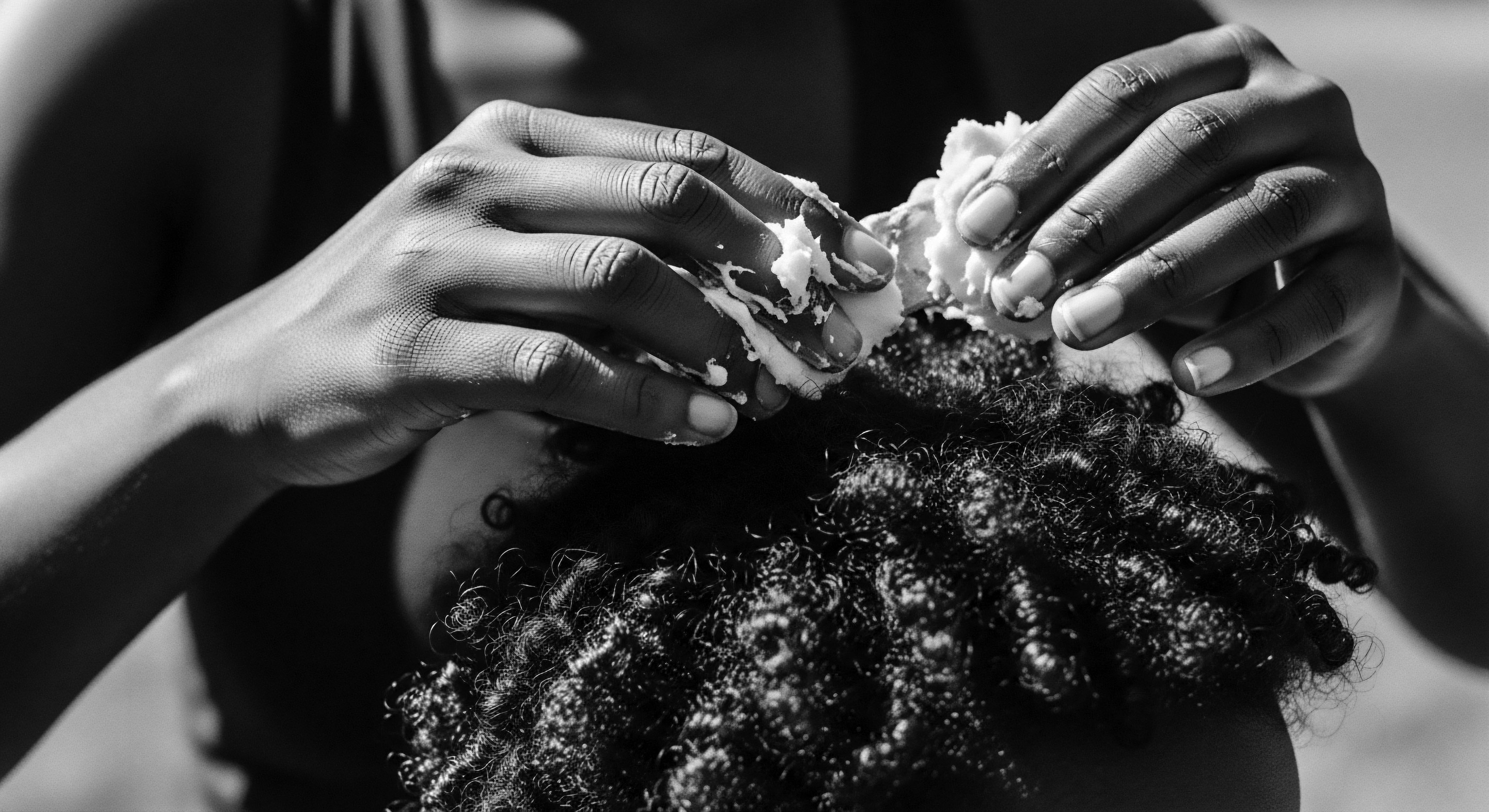
Biophysical Mechanisms and Ancestral Ingenuity
The efficacy of traditional and contemporary Overnight Hair Protection methods can be understood through their direct impact on the biophysical properties of hair.
- Mitigation of Mechanical Stress ❉ The primary function of smooth coverings like satin or silk bonnets is to create a low-friction interface. The smooth surface of these materials drastically reduces the shear forces and abrasive contact that occur as one shifts during sleep. This preserves the outer cuticle layer, which acts as the hair’s primary defense against environmental damage and moisture loss. A reduction in friction directly translates to fewer lifted cuticles, minimizing snagging and tangling, and consequently, less mechanical breakage.
- Optimized Hydration Homeostasis ❉ Textured hair’s inherent structure, with its numerous bends and twists, allows for increased surface area exposure, leading to a higher rate of moisture evaporation. Traditional cotton pillowcases exacerbate this by absorbing moisture from the hair. In contrast, non-absorbent materials like silk maintain a localized humid microclimate around the hair, preventing excessive moisture depletion. This is critical for maintaining the hair’s elasticity and pliability, preventing the brittle state that precedes breakage. The use of natural oils and butters as pre-sleep treatments, a practice common in many ancestral traditions, further enhances this moisture barrier, creating a symbiotic relationship with the protective covering.
- Preservation of Hair Architecture ❉ Techniques such as loose braiding, twisting, or “pineappling” are not merely stylistic choices; they are methods of macro-structural preservation. By consolidating hair into larger, contained units, these practices prevent individual strands from rubbing against each other or the sleeping surface in a chaotic manner. This maintains the integrity of the hair’s natural curl pattern, reducing the need for daily heat styling or excessive manipulation, which are significant contributors to hair damage. This echoes ancient practices where elaborate hairstyles were preserved for days or weeks, often under protective coverings, demonstrating a long-standing understanding of minimizing daily disturbance.
The historical trajectory of these practices reveals a continuous thread of ingenuity within Black and mixed-race communities. During enslavement, despite efforts to strip away identity through forced hair shaving and covering, Black women transformed these coverings into symbols of resistance and self-expression, implicitly maintaining hair health under duress, This demonstrates a deep-seated cultural knowledge of hair care, adapted and sustained even in the most challenging circumstances.
Consider the case of the Afar people in Northeastern Ethiopia, where ethnobotanical studies document the traditional use of various plant species for hair and skin care. A study identified 17 plant species used for hair and skin care, with a high Informant Consensus Factor (ICF) of 0.95, indicating strong agreement among informants on their traditional uses. Specifically, Ziziphus Spina-Christi (L.) Willd. and Sesamum Orientale L. were highly preferred for hair treatments, often applied topically as leave-in conditioners or cleansing agents. This highlights how ancestral communities, through generations of empirical observation, developed sophisticated natural solutions for hair protection and maintenance, many of which align with modern scientific understanding of moisture retention and scalp health.
The leaves were the most frequently utilized plant part, and water was the primary medium for preparations. This practice, rooted in the availability of local botanicals, provided a natural form of overnight nourishment and protection, preventing dryness and damage, much like modern leave-in treatments paired with protective coverings.
Academic inquiry reveals Overnight Hair Protection as a sophisticated bio-engineering solution, mitigating mechanical stress and optimizing hydration to preserve the complex structure of textured hair, a practice deeply informed by ancestral knowledge.
The academic examination of Overnight Hair Protection also necessitates an exploration of its psychosocial dimensions. Hair, particularly for individuals of African descent, is inextricably linked to identity, self-esteem, and cultural expression, The consistent practice of protecting hair overnight contributes not only to its physical health but also to a sense of self-care and continuity with ancestral traditions. It is a daily ritual that reaffirms a connection to heritage, resisting Eurocentric beauty standards that historically devalued textured hair, This ongoing act of preservation, therefore, extends beyond the purely physiological, becoming a powerful statement of cultural affirmation and resilience. The conscious choice to maintain and honor textured hair through practices like overnight protection stands as a testament to the enduring spirit of Black and mixed-race communities globally,
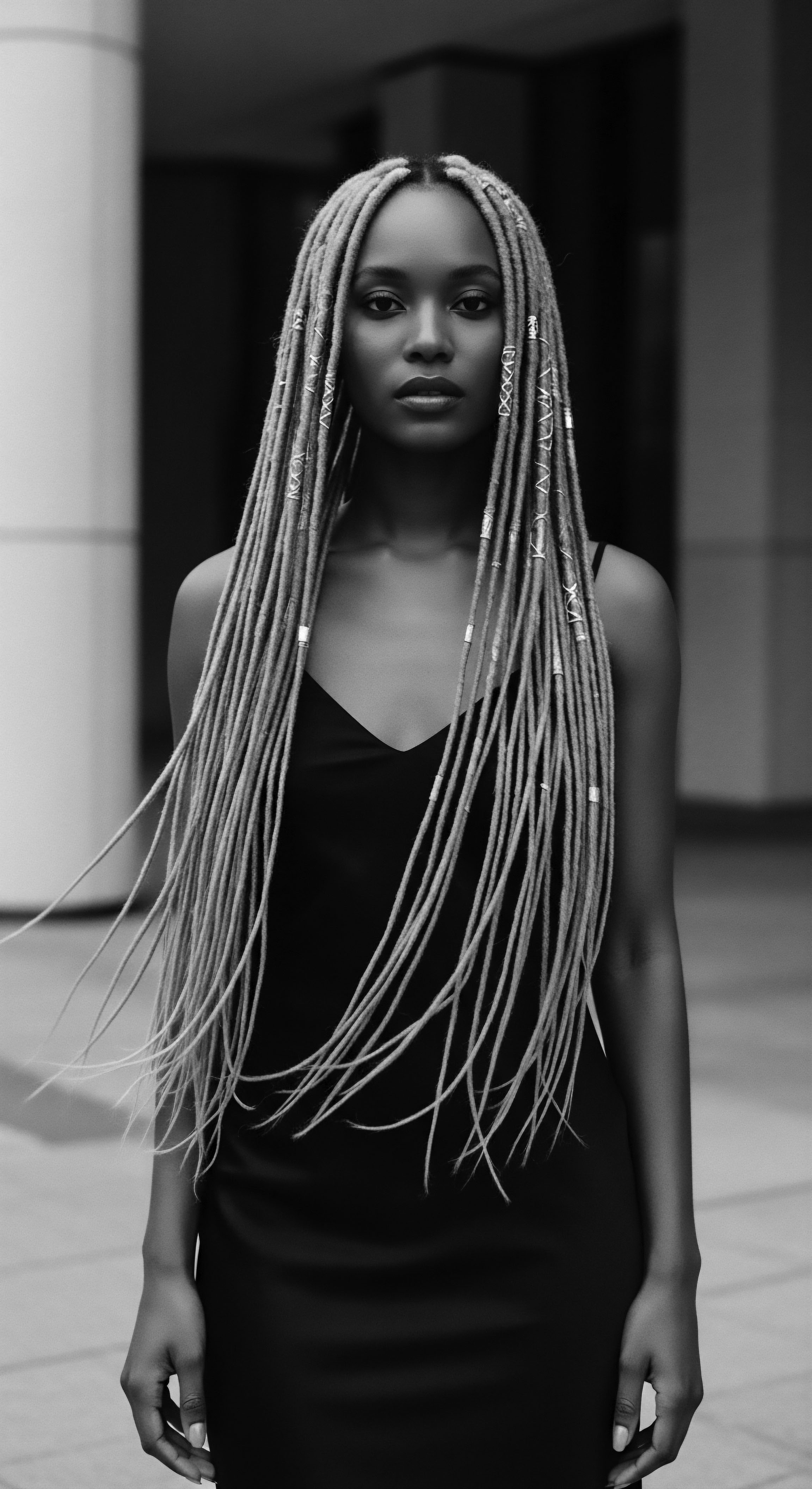
Reflection on the Heritage of Overnight Hair Protection
The journey through the meaning of Overnight Hair Protection has been a profound meditation on the enduring spirit of textured hair and its custodians. It is clear that this practice is far more than a mere nocturnal routine; it is a living archive, a whispered story passed from elder to youth, a testament to the resilience and ingenuity woven into the very soul of a strand. From the ancestral hearths where oils were lovingly massaged and hair carefully bound, to the contemporary spaces where satin bonnets adorn bedside tables, a continuous thread of care, wisdom, and defiance runs through the generations.
The act of protecting hair overnight, especially for those with Black and mixed-race hair, stands as a quiet yet powerful affirmation of self and lineage. It speaks to a deep, intuitive understanding of the hair’s unique needs, born from centuries of observation and adaptation. This is not a practice that emerged from fleeting trends; rather, it is a deeply ingrained cultural artifact, refined through periods of both celebration and subjugation. Each protective wrap, each carefully chosen fabric, carries the echoes of those who, despite immense pressures, refused to let their crowns be diminished.
In every curl, every coil, every twist lies a history—a history of beauty, resistance, and unyielding self-preservation. The deliberate choice to safeguard one’s hair while sleeping is an act of reverence for this heritage, a recognition that our hair is not just a biological extension, but a vibrant conduit to our past and a declaration for our future. It reminds us that true wellness extends beyond the visible, reaching into the sacred space where ancestral wisdom meets modern understanding, ensuring that the legacy of our strands remains vibrant and unbound.
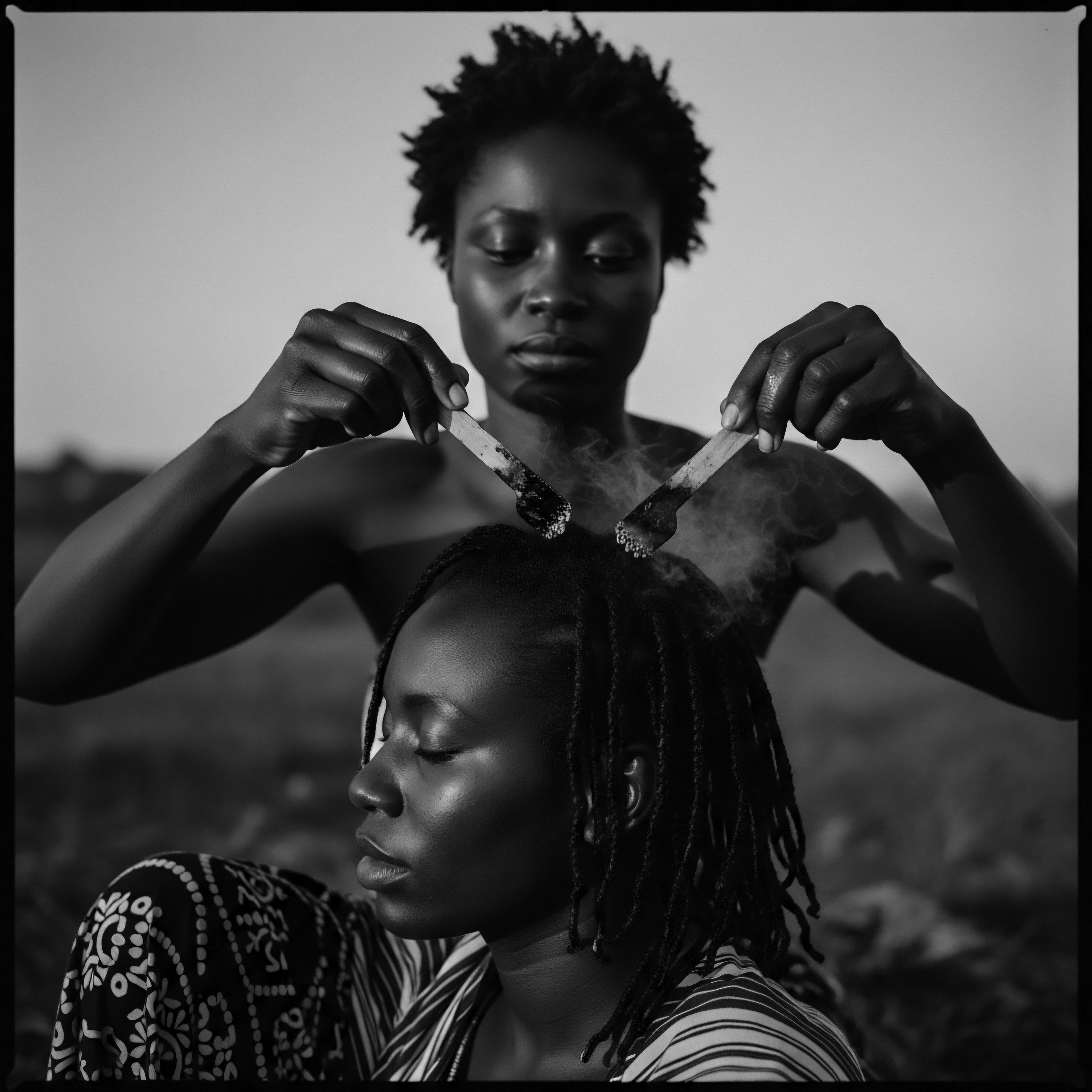
References
- Wilderness. (2015). The history & meaning of head wraps across Africa .
- sonson. (2021). The History of Headwraps and Black Culture .
- Helix Hair Labs. (2023). THE HISTORY OF THE HAIR BONNET .
- Road Test ❉ I tried silk hair wraps and pillowcases to see if they improved my hair health. (2024).
- Hair Care Practices from the Diaspora ❉ A Look at Africa, America, and Europe. (2025).
- JD Institute of Fashion Technology. (2021). HEADWRAPS ❉ HISTORY AND EVOLUTION .
- Oxford Research Encyclopedia of Communication. (2024). Black Diaspora and Media Use .
- Scholar Commons. Examining Afrocentricity and Identity Through the Reemergence and Expression of Natural Hair i .
- Addis, W. Zeynu, A. Eyado, A. & Mekonnen, Y. (2025). Plants used for hair and skin health care by local communities of Afar, Northeastern Ethiopia .
- ResearchGate. (2025). Empirical -Qualitative Exploring Her Roots ❉ Black Caribbean Hair Identity and Going Natural Using Social Media Networks .
- Library of Congress. Heavy is the Head ❉ Evolution of African Hair in America from the 17th c. to the 20th c.
- Ethnobotany Research and Applications. (2025). Plants used for hair and skin health care by local communities of Afar, Northeastern Ethiopia .
- ResearchGate. (2024). (PDF) Ethnobotany of traditional plant cosmetics utilized by women; A study in Northern Ghana .
- YorkSpace. (2021). Braided Archives ❉ Black hair as a site of diasporic transindividuation Océane Nyela A Thesis Submitted to the Faculty of Gradua .
- CLoK – Central Lancashire online Knowledge. Restyling Blackness ❉ .
